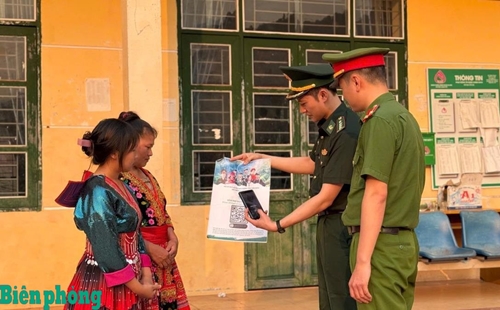A simple yet effective initiative, titled “Anonymous digital mailbox for reporting crime and illegal border crossings,” has helped residents confidentially report crimes and illegal border crossings via their smartphones. The initiative of applying IT to mass mobilization work has contributed to enhancing the effectiveness of the “Good mass mobilization” movement and “Good mass mobilization units” and the protection of border security in the new situation.
Applying IT to mass mobilization work
Quang Lam, a mountainous border area predominantly inhabited by ethnic minorities, faces complex socio-economic challenges and latent criminal threats. Border guard officers often face difficulties in communicating and mobilizing local communities. In early 2024, to renew dissemination methods and improve coordination in maintaining public security, Na Co Sa Border Post launched the anonymous digital mailbox initiative.
    |
 |
|
Troops of Na Co Sa Border Post guiding people to apply digital technology to reporting crime |
Designed to fit local conditions, this tech-based model encourages public participation while ensuring confidentiality and convenience. The digital system uses QR-code posters displayed in public areas such as health stations, schools, cultural centers, and local markets. Citizens simply scan the QR code using their smartphone camera or the Zalo app to access an anonymous online form. Submissions are then sent directly to the station’s encrypted email system, ensuring timely and secure communication.
Deputy Political Officer of Na Co Sa Border Post and author of the model Major Do Xuan Diem said, “The important thing is that people feel safe and confident when using it. The system does not require names or logins, which reassures residents and encourages them to share valuable information that helps keep their villages safe.”
Since the model was launched, local residents have shown increased vigilance and a stronger sense of responsibility for community safety. Between early 2024 and June 2025, the border post received nearly 50 credible reports through the mailbox. These led to the prompt resolution of two theft cases, the voluntary handover of two homemade firearms, and the detection and expulsion of six individuals residing illegally in the area.
“Thanks to timely information from residents, we were able to prevent several incidents at a very early stage,” Maj. Diem noted, emphasizing how early warning plays a critical role in border security.
Expanding effective model
To maximize its impact, the border post actively trains villagers to use the system. Officers visit each hamlet, working closely with local leaders and self-managed security groups to demonstrate how to scan QR codes and submit reports. The process is explained in both the official Vietnamese and H’mong languages, tailored to residents’ education levels. For the elderly or those unfamiliar with digital tools, officers provide hands-on guidance to ensure ease of use.
In addition, the unit utilizes Zalo, its official fan page, and mobile loudspeakers to update residents on border issues. All information submitted through the digital mailbox is handled confidentially and according to legal protocols. Officers in charge of the work had been thoroughly trained in secure data handling and unbiased response procedures.
This model not only facilitates crime reporting but also fosters a two-way dialogue between border guards and the public. It empowers local communities to voice concerns and participate in public security, reinforcing democratic values at the grassroots level.
Remarkably, the model requires minimal financial investment or advanced technology skills. In today’s complex border management landscape, especially with the rise of high-tech crimes, applying digital solutions to mass mobilization work is a forward-looking strategy.
The outcome of the model has contributed to solidifying public support, building community trust. They become a critical soft-power element of national defense. In challenging terrain and isolated communities, technology provides a breakthrough in both communication and mobilization. By enabling residents to actively contribute to national border protection, the initiative turns ordinary people into the first line of defense.
Looking ahead, Na Co Sa Border Post plans to expand the model further, integrating additional digital interaction channels in line with the Vietnam Border Guard’s ongoing digital transformation strategy.
Translated by Tran Hoai